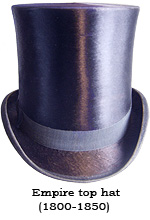 In the 18e century, the young elegant class in England became what was known as Dandies. Many regard Charles II as the trendsetter and the first Dandy. The Grand Tour of Europe also took the English Dandy to Italy and France. In London, these travelled young men formed the 'Macaroni Club', bringing some southern elegance to their grey and overcast country. From 1770-1790, the Dandies of the Macaroni Club wore white neck-ties knotted into a bow.
In the 18e century, the young elegant class in England became what was known as Dandies. Many regard Charles II as the trendsetter and the first Dandy. The Grand Tour of Europe also took the English Dandy to Italy and France. In London, these travelled young men formed the 'Macaroni Club', bringing some southern elegance to their grey and overcast country. From 1770-1790, the Dandies of the Macaroni Club wore white neck-ties knotted into a bow.At the start of the 19th century, George Bryan Brummel was the uncrowned king of the Dandies. Brummels disassociated himself from extreme fashion trends and announced the rule of thumb that still applies to this day: 'the sign of a good dresser is someone who does not attract attention'. Brummel advised King George IV: 'Tying a white neck-tie in a bow will have to be the highlight of everyday life'.
It was against this backdrop that the Silk Top Hat came into being in 1797 and made its way to the Netherlands from England via France. Although people already wore top hats in the 16th century, these were only covered in silk plush in 1797.
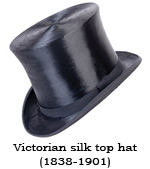 The black silk top hat was made from cheesecloth, linen, flannel and shellac. Using various types of flat-irons, the shellac was 'baked' in the linen around a five-piece wooden hat block and covered with black silk plush, which came mostly from France. Only the master tradesman (foreman) was permitted to cut the expensive silk. The hat was finished with a 2½ to 3 cm wide cloth hatband, which was later replaced by one of ribbed silk. The brim of the hat also had a ribbed band. During this early Victorian time - i.e. approximately 1830 - top hats were extremely tall, some even reaching 20 cm.
The black silk top hat was made from cheesecloth, linen, flannel and shellac. Using various types of flat-irons, the shellac was 'baked' in the linen around a five-piece wooden hat block and covered with black silk plush, which came mostly from France. Only the master tradesman (foreman) was permitted to cut the expensive silk. The hat was finished with a 2½ to 3 cm wide cloth hatband, which was later replaced by one of ribbed silk. The brim of the hat also had a ribbed band. During this early Victorian time - i.e. approximately 1830 - top hats were extremely tall, some even reaching 20 cm.Later in the Victorian era, from 1837 to 1901, the height was reduced to between 16 and 17 cm. Around 1890, the top hat also received a larger crown, so appearing more tailored or 'nipped in'. From around 1920, top hats were around 12 to 13 cm in height. That still applies today.
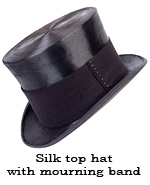
As a sign of mourning, families and friends would place a wide cloth mourning band around their hats, mostly with a vertical row of tiny silk buttons on the sides. The wider a mourning band was, the more important the funeral. The funeral announcer had a black mourning veil hanging from his hat. Fifty years earlier, the announcer had still worn a three-sided cocked hat with mourning veil.
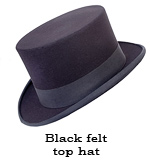
The black felt top hat has been used since approximately 1900 for funeral services. Nowadays, dull wool felt is used by the pallbearers and fur felt is used by the undertakers. Particularly hare's fur felt has replaced the classic silk top hat since the sixties. The usual height is between 12 and 13 cm.
The black mourning cocked hat obviously reminds one of Napoleon. The cocked hat was adorned with a black ostrich plume, among other things, and worn in earlier years by the funeral announcer and pastor, whilst the coachman still wears a ladder stitch on the coach-box. Since earliest Victorian time, English etiquette has required a long, thin tie to be worn on the coach-box. This tie, which is still known today, originated in the mid 19th century and is called four-in-hand after the carriage drawn by a team of four horses.

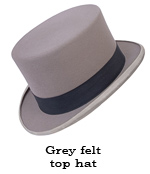 The grey top hat hat has been used for wedding ceremonies since 1960 and actually comes from the Ascot horse races. It is around 12 - 14 cm in height and is made from wool felt. Felt top hats are still made today.
The grey top hat hat has been used for wedding ceremonies since 1960 and actually comes from the Ascot horse races. It is around 12 - 14 cm in height and is made from wool felt. Felt top hats are still made today.The black ladies' riding hat is around 8 -10 cm in height and has also been made from hare's fur felt since 1970.
The opera hat is covered in stretched black silk satin. There is a mechanism inside the hat which can be used to collapse it. These hats were used in earlier times by opera-goers and also saved space in overcrowded cloakrooms.
No comments:
Post a Comment